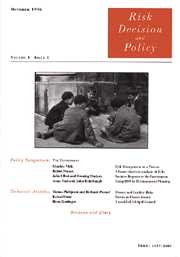Article contents
Risk reduction when transporting dangerous goods: road or rail?
Published online by Cambridge University Press: 22 May 2002
Abstract
The opportunity of switching from road to rail or to a combination of road and rail (intermodal) transport is being considered in many countries with the objective of risk reduction in the transport of dangerous goods. This work presents a quantitative approach based on risk analysis for comparing the hazards of road, rail, and intermodal transport, aimed at defining criteria for selecting the safest transport modality. When comparing road and rail transport, the risk mainly depends on the hazardous characteristics of the product. The size of the containers is generally larger for rail transport than for road transport, and consequently the amount of product potentially released, giving rise to impact areas slightly or significantly larger for rail than for road transport. When comparing road and intermodal transport, route length plays the most significant role: the longer the distance, the safer the intermodal transport.
- Type
- Technical Article
- Information
- Copyright
- © Risk Decision and Policy, 2002
- 9
- Cited by




